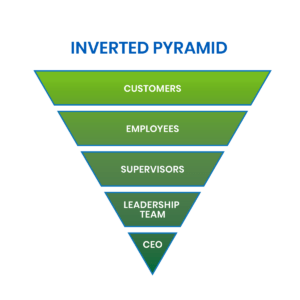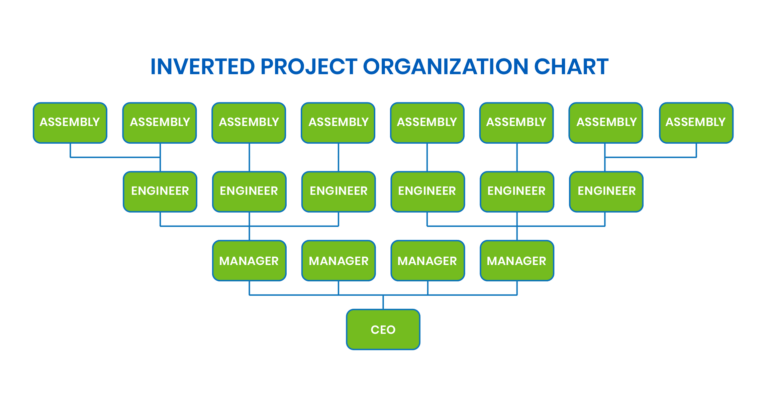Re-Organizing your Organization: Inverted Org Charts
We have entered a new era of work. Organizations need to be agile. They need to innovate, respond, adjust, and pivot faster than ever. People are leaving their jobs in record numbers because they are no longer looking for just a “job.” They want to be engaged in a mission and have a purpose. They want to be part of something bigger. They want to be part of a work culture that encourages them to learn, grow, and make a difference. The old top-down, command and control structure no longer fits the market or people’s needs and desires. How do we move forward?
What if you flip your organizational chart on its head or inside out?

According to research done by Deloitte Insights, 92% of companies surveyed believe organizational restructuring is important to their success. This realization has led many companies to abandon their hierarchical structure for something completely different: an inverted organizational chart, or inverted pyramid. They are constructing organizations that put the front-line employees at the top of the structure and focus on building a culture that encourages innovation, accountability, and a sense of belonging.
Make your organizational restructuring a smooth process for your team.
What does an inverted organizational chart do for your organization?
An inverted organizational chart is all about creating a culture that allows your organization to be more flexible and agile. It creates a culture that empowers team members and redefines leadership roles as supportive and mentor-focused rather than authoritarian.
- It eliminates some of the bottlenecks that happen when all decisions are made by management.
- It makes your organization able to respond to changing market conditions more quickly.
- It encourages your employees to be more innovative and creative.
- It improves collaboration between teams by removing the silos that often result from the traditional org chart.
For this new network-of-teams structure to be effective, clear communication must be a key focus. Transparency must replace information hoarding. Leaders and team members must be willing to share their knowledge and resources with others for the benefit of the organization and its shareholders, both internal and external.
Transparency can be challenging on many levels, especially in remote and hybrid work environments, but it can become a natural part of a collaborative culture by enacting and consistently following well-defined processes.
What does an inverted organizational chart do for your employees?
When you create a culture that removes the restriction of authoritarian leadership and encourages innovation in every role, you empower your team members and engage them in ways that delegation can’t duplicate.
- You encourage them to question ideas and be actively involved in resolving issues.
- You allow them to be involved in setting their individual and team goals and objectives, and you give them control over how they reach those goals and objectives.
- Your employees will feel accountable for themselves, their team, the organization, and your customers because they are invested in what your company is trying to achieve.
This culture of collaboration and transparency provides the space that employees need to feel safe enough to learn from their mistakes, try new things, and grow. They may want to deepen their knowledge within their current role or broaden their skills by branching out into new areas. Work with your team members to set professional growth objectives that encourage them to continue to expand their expertise. Involve them in creating the inverted organization chart for your business.

What does an inverted organizational chart do for you, the leader?
The good news is that those in leadership roles are no longer required to have all the answers! It does change the concept of leadership to more of a mentoring or coaching role than the traditional figure-it-out and delegate role.
- You support and assist your team in discovering the best solutions for themselves.
- You facilitate the growth of your team members and empower them to make many of the decisions traditionally made by management.
With an inverted pyramid, your organization will be comprised of engaged and accountable individuals, freeing up the senior leadership to focus on the strategy and business plan rather than getting stuck in the weeds.
- You will be able to work on the business to advance the vision and culture rather than working on the day-to-day issues of the business.
- You will promote and facilitate communication between teams and reinforce the culture at every opportunity to ensure the success and growth of the organization.
What does an inverted organizational chart require from the leadership?
An inverted org chart is not an easy change to make. It may require a mindset change from the leadership and team, which can be challenging. Everyone will be required to step outside their comfort zone by taking on a role that will stretch them. That is often met with some resistance. It’s important to help them understand how these changes will positively impact their role and make their work life more fulfilling.
Inverting your organizational structure is a process, not an immediate transformation. Provide support to the leadership team during the transition with a mentoring/coaching leadership role. You may choose to invest in business and leadership coaching to make the change as productive and easy as possible.
At The Next Step, our business experts have spent decades in various roles across the manufacturing industry. Tap into our knowledge for a smoother transition.
We’ve talked a lot about culture – what does it mean?
Culture all starts with a vision and a mission. Your organization’s mission is its “why” and, in the words of Simon Sinek, you must Start with Why. With a vision and a mission, the purpose of the organization is more than just to be profitable. It’s bigger than the products and services it offers. By identifying the reason your organization exists, you create a unifying purpose that inspires team members to come to work every day. You give customers a more meaningful reason to buy your products and services because they align with the “why” behind the ”what” that you do.
Along with your company’s mission statement, you need to identify the core values that you want to be woven into the fabric of your organization. These are not simply words or phrases that hang on a wall somewhere or show up on your website. They will reflect what is important to your company and will provide the basis for how you live out your mission.
The core values will inform your interactions with internal and external stakeholders. They are the yardstick that helps you hire and retain the right team members. The mission statement and core values will be included in the onboarding and ongoing training of every individual working for your organization.
No question re-organizing your company to an inverted organizational chart is a lot of work, but the rewards are definitely worth it! By making the necessary structural changes now, you and your team will be ready to thrive as you move into the future. Our HR experts can help take the work of re-organizing your organizational structure off your hands, so you can focus your efforts elsewhere.
Contact us today and start the discussion!
“Corporate culture is the only sustainable competitive advantage that is completely within the control of the entrepreneur. Develop a strong corporate culture first and foremost.”
David Cummings, Co-founder of Pardot




